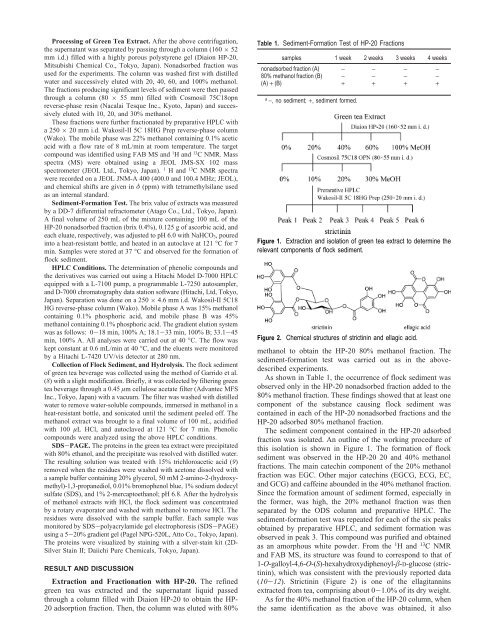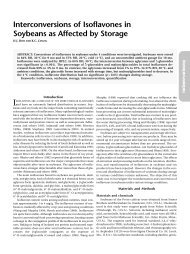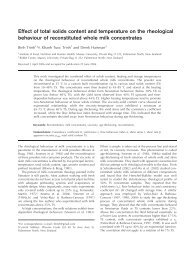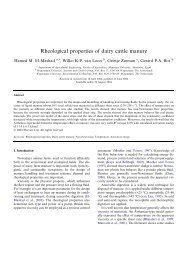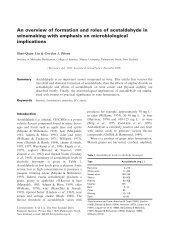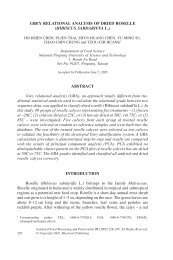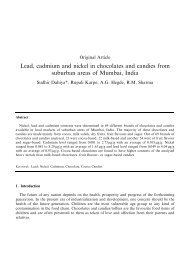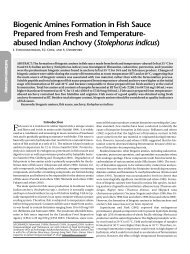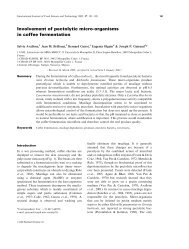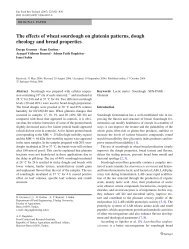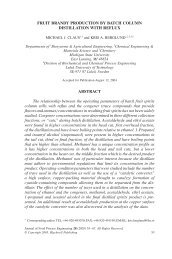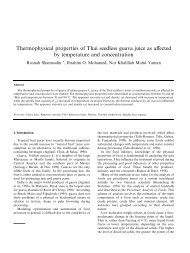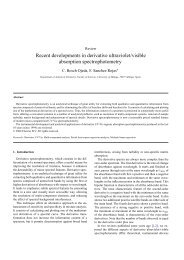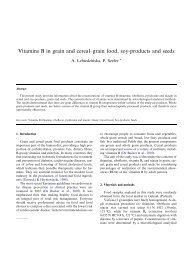Determination of Mechanism of Flock Sediment Formation in Tea ...
Determination of Mechanism of Flock Sediment Formation in Tea ...
Determination of Mechanism of Flock Sediment Formation in Tea ...
Create successful ePaper yourself
Turn your PDF publications into a flip-book with our unique Google optimized e-Paper software.
Process<strong>in</strong>g <strong>of</strong> Green <strong>Tea</strong> Extract. After the above centrifugation,<br />
the supernatant was separated by pass<strong>in</strong>g through a column (160 × 52<br />
mm i.d.) filled with a highly porous polystyrene gel (Diaion HP-20,<br />
Mitsubishi Chemical Co., Tokyo, Japan). Nonadsorbed fraction was<br />
used for the experiments. The column was washed first with distilled<br />
water and successively eluted with 20, 40, 60, and 100% methanol.<br />
The fractions produc<strong>in</strong>g significant levels <strong>of</strong> sediment were then passed<br />
through a column (80 × 55 mm) filled with Cosmosil 75C18opn<br />
reverse-phase res<strong>in</strong> (Nacalai Tesque Inc., Kyoto, Japan) and successively<br />
eluted with 10, 20, and 30% methanol.<br />
These fractions were further fractionated by preparative HPLC with<br />
a 250 × 20 mm i.d. Wakosil-II 5C 18HG Prep reverse-phase column<br />
(Wako). The mobile phase was 22% methanol conta<strong>in</strong><strong>in</strong>g 0.1% acetic<br />
acid with a flow rate <strong>of</strong> 8 mL/m<strong>in</strong> at room temperature. The target<br />
compound was identified us<strong>in</strong>g FAB MS and 1 H and 13 C NMR. Mass<br />
spectra (MS) were obta<strong>in</strong>ed us<strong>in</strong>g a JEOL JMS-SX 102 mass<br />
spectrometer (JEOL Ltd., Tokyo, Japan). 1 H and 13 C NMR spectra<br />
were recorded on a JEOL JNM-A 400 (400.0 and 100.4 MHz; JEOL),<br />
and chemical shifts are given <strong>in</strong> δ (ppm) with tetramethylsilane used<br />
as an <strong>in</strong>ternal standard.<br />
<strong>Sediment</strong>-<strong>Formation</strong> Test. The brix value <strong>of</strong> extracts was measured<br />
by a DD-7 differential refractometer (Atago Co., Ltd., Tokyo, Japan).<br />
A f<strong>in</strong>al volume <strong>of</strong> 250 mL <strong>of</strong> the mixture conta<strong>in</strong><strong>in</strong>g 100 mL <strong>of</strong> the<br />
HP-20 nonadsorbed fraction (brix 0.4%), 0.125 g <strong>of</strong> ascorbic acid, and<br />
each eluate, respectively, was adjusted to pH 6.0 with NaHCO3, poured<br />
<strong>in</strong>to a heat-resistant bottle, and heated <strong>in</strong> an autoclave at 121 °C for 7<br />
m<strong>in</strong>. Samples were stored at 37 °C and observed for the formation <strong>of</strong><br />
flock sediment.<br />
HPLC Conditions. The determ<strong>in</strong>ation <strong>of</strong> phenolic compounds and<br />
the derivatives was carried out us<strong>in</strong>g a Hitachi Model D-7000 HPLC<br />
equipped with a L-7100 pump, a programmable L-7250 autosampler,<br />
and D-7000 chromatography data station s<strong>of</strong>tware (Hitachi, Ltd, Tokyo,<br />
Japan). Separation was done on a 250 × 4.6 mm i.d. Wakosil-II 5C18<br />
HG reverse-phase column (Wako). Mobile phase A was 15% methanol<br />
conta<strong>in</strong><strong>in</strong>g 0.1% phosphoric acid, and mobile phase B was 45%<br />
methanol conta<strong>in</strong><strong>in</strong>g 0.1% phosphoric acid. The gradient elution system<br />
was as follows: 0-18 m<strong>in</strong>, 100% A; 18.1-33 m<strong>in</strong>, 100% B; 33.1-45<br />
m<strong>in</strong>, 100% A. All analyses were carried out at 40 °C. The flow was<br />
kept constant at 0.6 mL/m<strong>in</strong> at 40 °C, and the eluents were monitored<br />
by a Hitachi L-7420 UV/vis detector at 280 nm.<br />
Collection <strong>of</strong> <strong>Flock</strong> <strong>Sediment</strong>, and Hydrolysis. The flock sediment<br />
<strong>of</strong> green tea beverage was collected us<strong>in</strong>g the method <strong>of</strong> Garrido et al.<br />
(8) with a slight modification. Briefly, it was collected by filter<strong>in</strong>g green<br />
tea beverage through a 0.45 µm cellulose acetate filter (Advantec MFS<br />
Inc., Tokyo, Japan) with a vacuum. The filter was washed with distilled<br />
water to remove water-soluble compounds, immersed <strong>in</strong> methanol <strong>in</strong> a<br />
heat-resistant bottle, and sonicated until the sediment peeled <strong>of</strong>f. The<br />
methanol extract was brought to a f<strong>in</strong>al volume <strong>of</strong> 100 mL, acidified<br />
with 100 µL HCl, and autoclaved at 121 °C for 7 m<strong>in</strong>. Phenolic<br />
compounds were analyzed us<strong>in</strong>g the above HPLC conditions.<br />
SDS-PAGE. The prote<strong>in</strong>s <strong>in</strong> the green tea extract were precipitated<br />
with 80% ethanol, and the precipitate was resolved with distilled water.<br />
The result<strong>in</strong>g solution was treated with 15% trichloroacetic acid (9)<br />
removed when the residues were washed with acetone dissolved with<br />
a sample buffer conta<strong>in</strong><strong>in</strong>g 20% glycerol, 50 mM 2-am<strong>in</strong>o-2-(hydroxymethyl)-1,3-propanediol,<br />
0.01% bromophenol blue, 1% sodium dodecyl<br />
sulfate (SDS), and 1% 2-mercaptoethanol; pH 6.8. After the hydrolysis<br />
<strong>of</strong> methanol extracts with HCl, the flock sediment was concentrated<br />
by a rotary evaporator and washed with methanol to remove HCl. The<br />
residues were dissolved with the sample buffer. Each sample was<br />
monitored by SDS-polyacrylamide gel electrophoresis (SDS-PAGE)<br />
us<strong>in</strong>g a 5-20% gradient gel (Pagel NPG-520L, Atto Co., Tokyo, Japan).<br />
The prote<strong>in</strong>s were visualized by sta<strong>in</strong><strong>in</strong>g with a silver-sta<strong>in</strong> kit (2D-<br />
Silver Sta<strong>in</strong> II; Daiichi Pure Chemicals, Tokyo, Japan).<br />
RESULT AND DISCUSSION<br />
Extraction and Fractionation with HP-20. The ref<strong>in</strong>ed<br />
green tea was extracted and the supernatant liquid passed<br />
through a column filled with Diaion HP-20 to obta<strong>in</strong> the HP-<br />
20 adsorption fraction. Then, the column was eluted with 80%<br />
Table 1. <strong>Sediment</strong>-<strong>Formation</strong> Test <strong>of</strong> HP-20 Fractions<br />
samples 1 week 2 weeks 3 weeks 4 weeks<br />
nonadsorbed fraction (A) − − − −<br />
80% methanol fraction (B) − − − −<br />
(A) + (B) + + + +<br />
a −, no sediment; +, sediment formed.<br />
Figure 1. Extraction and isolation <strong>of</strong> green tea extract to determ<strong>in</strong>e the<br />
relevant components <strong>of</strong> flock sediment.<br />
Figure 2. Chemical structures <strong>of</strong> strict<strong>in</strong><strong>in</strong> and ellagic acid.<br />
methanol to obta<strong>in</strong> the HP-20 80% methanol fraction. The<br />
sediment-formation test was carried out as <strong>in</strong> the abovedescribed<br />
experiments.<br />
As shown <strong>in</strong> Table 1, the occurrence <strong>of</strong> flock sediment was<br />
observed only <strong>in</strong> the HP-20 nonadsorbed fraction added to the<br />
80% methanol fraction. These f<strong>in</strong>d<strong>in</strong>gs showed that at least one<br />
component <strong>of</strong> the substance caus<strong>in</strong>g flock sediment was<br />
conta<strong>in</strong>ed <strong>in</strong> each <strong>of</strong> the HP-20 nonadsorbed fractions and the<br />
HP-20 adsorbed 80% methanol fraction.<br />
The sediment component conta<strong>in</strong>ed <strong>in</strong> the HP-20 adsorbed<br />
fraction was isolated. An outl<strong>in</strong>e <strong>of</strong> the work<strong>in</strong>g procedure <strong>of</strong><br />
this isolation is shown <strong>in</strong> Figure 1. The formation <strong>of</strong> flock<br />
sediment was observed <strong>in</strong> the HP-20 20 and 40% methanol<br />
fractions. The ma<strong>in</strong> catech<strong>in</strong> component <strong>of</strong> the 20% methanol<br />
fraction was EGC. Other major catech<strong>in</strong>s (EGCG, ECG, EC,<br />
and GCG) and caffe<strong>in</strong>e abounded <strong>in</strong> the 40% methanol fraction.<br />
S<strong>in</strong>ce the formation amount <strong>of</strong> sediment formed, especially <strong>in</strong><br />
the former, was high, the 20% methanol fraction was then<br />
separated by the ODS column and preparative HPLC. The<br />
sediment-formation test was repeated for each <strong>of</strong> the six peaks<br />
obta<strong>in</strong>ed by preparative HPLC, and sediment formation was<br />
observed <strong>in</strong> peak 3. This compound was purified and obta<strong>in</strong>ed<br />
as an amorphous white powder. From the 1 H and 13 C NMR<br />
and FAB MS, its structure was found to correspond to that <strong>of</strong><br />
1-O-galloyl-4,6-O-(S)-hexahydroxydiphenoyl--D-glucose (strict<strong>in</strong><strong>in</strong>),<br />
which was consistent with the previously reported data<br />
(10-12). Strict<strong>in</strong><strong>in</strong> (Figure 2) is one <strong>of</strong> the ellagitann<strong>in</strong>s<br />
extracted from tea, compris<strong>in</strong>g about 0-1.0% <strong>of</strong> its dry weight.<br />
As for the 40% methanol fraction <strong>of</strong> the HP-20 column, when<br />
the same identification as the above was obta<strong>in</strong>ed, it also


